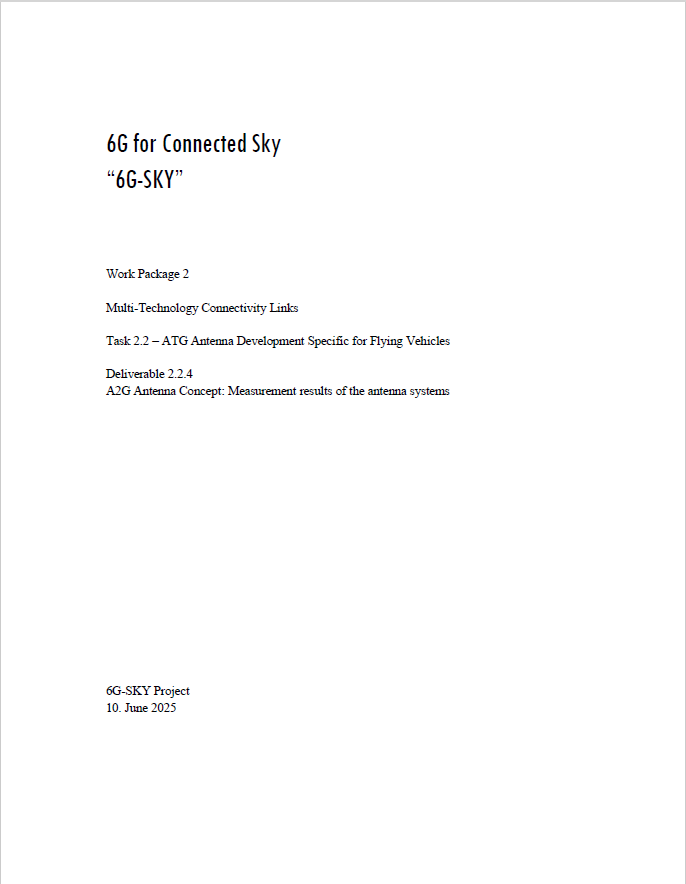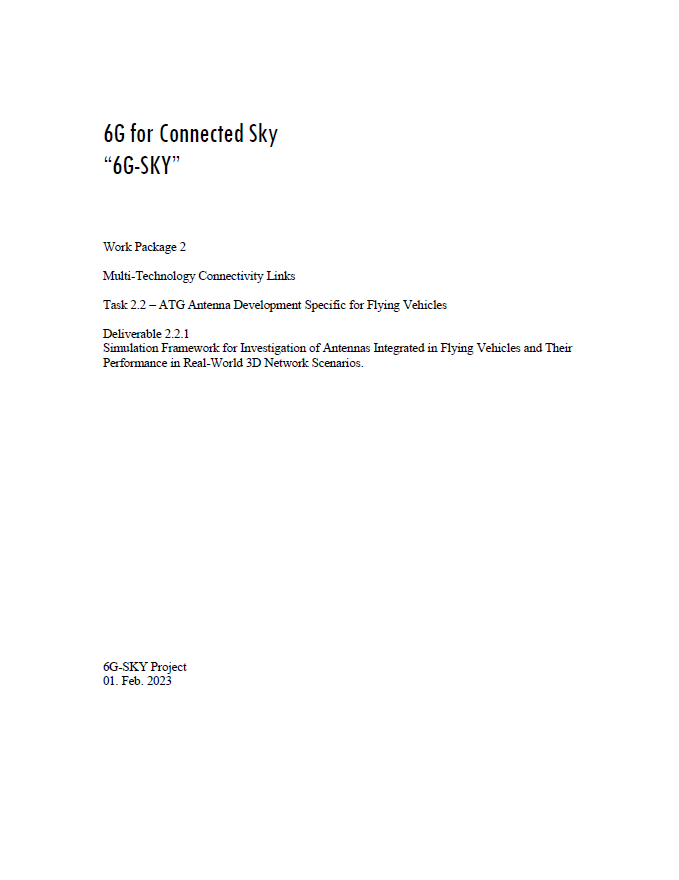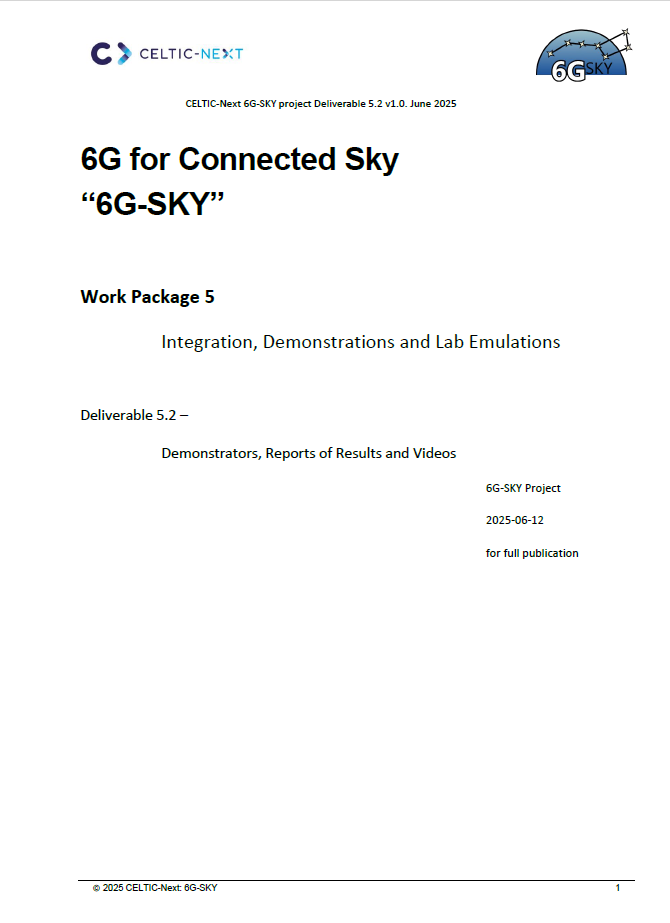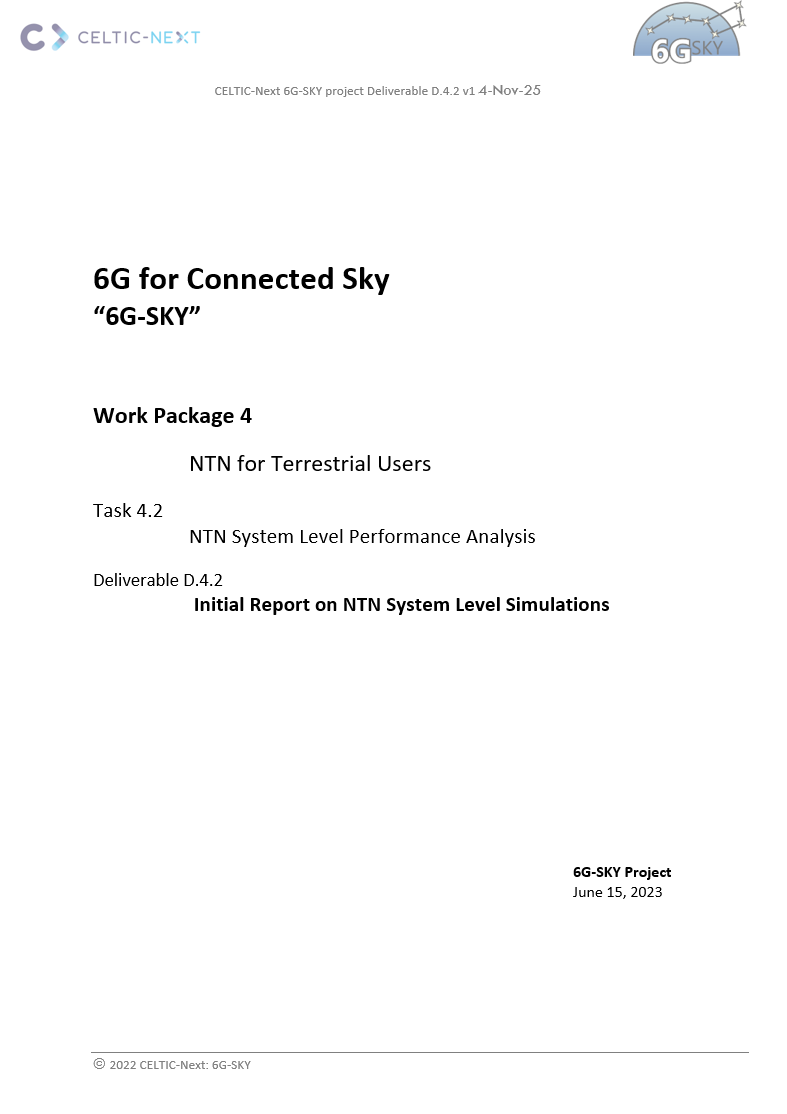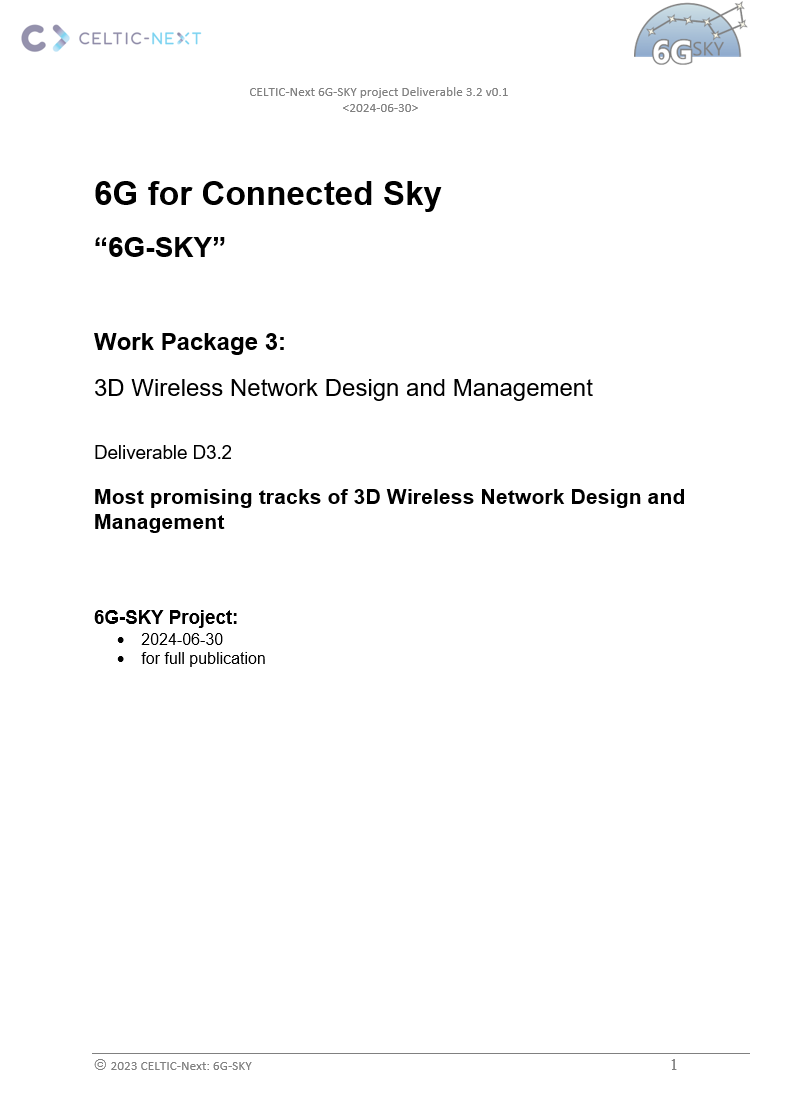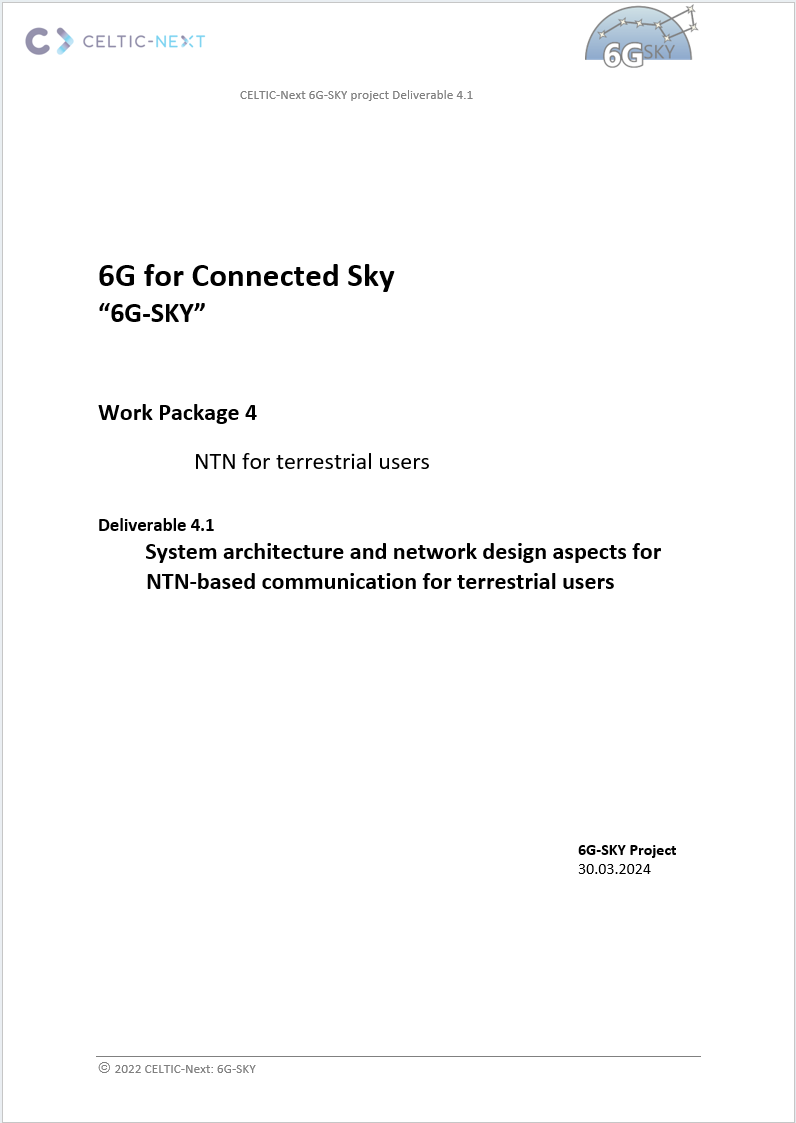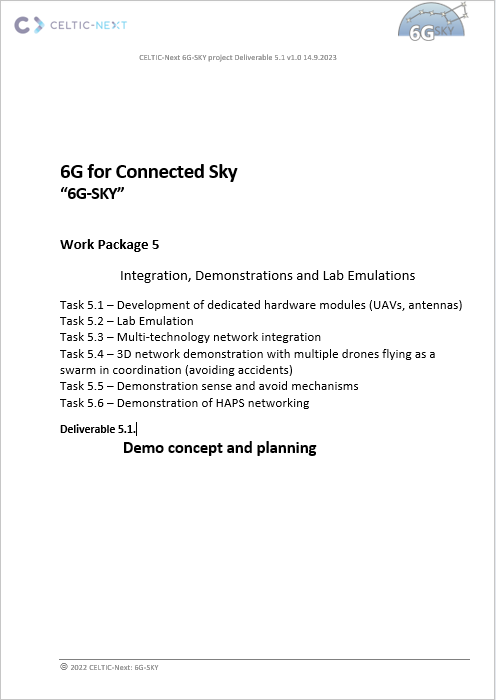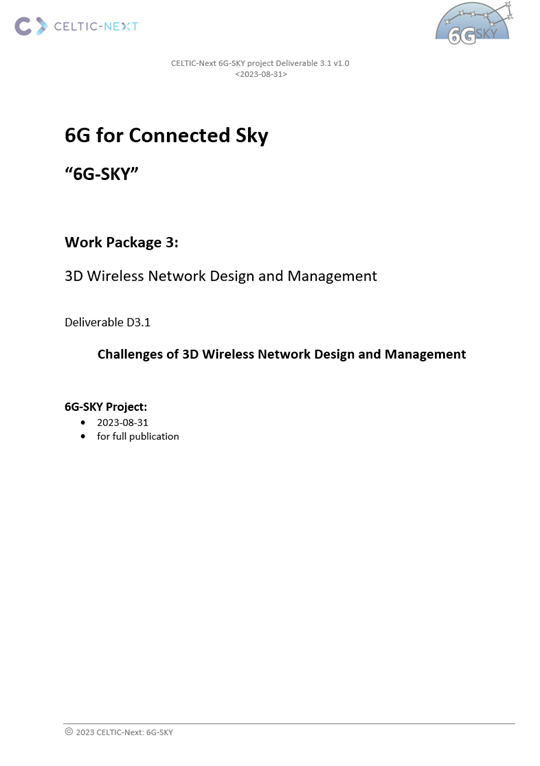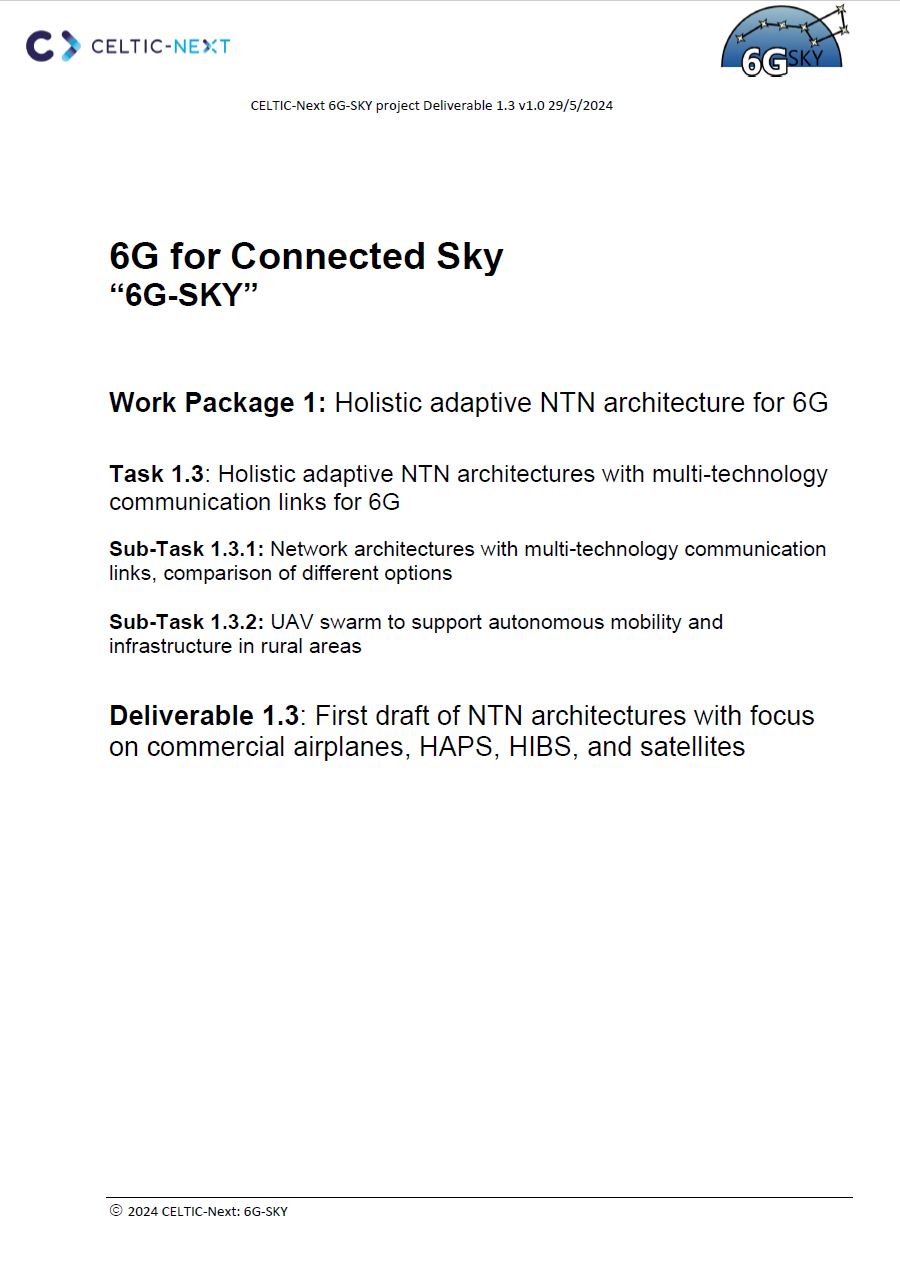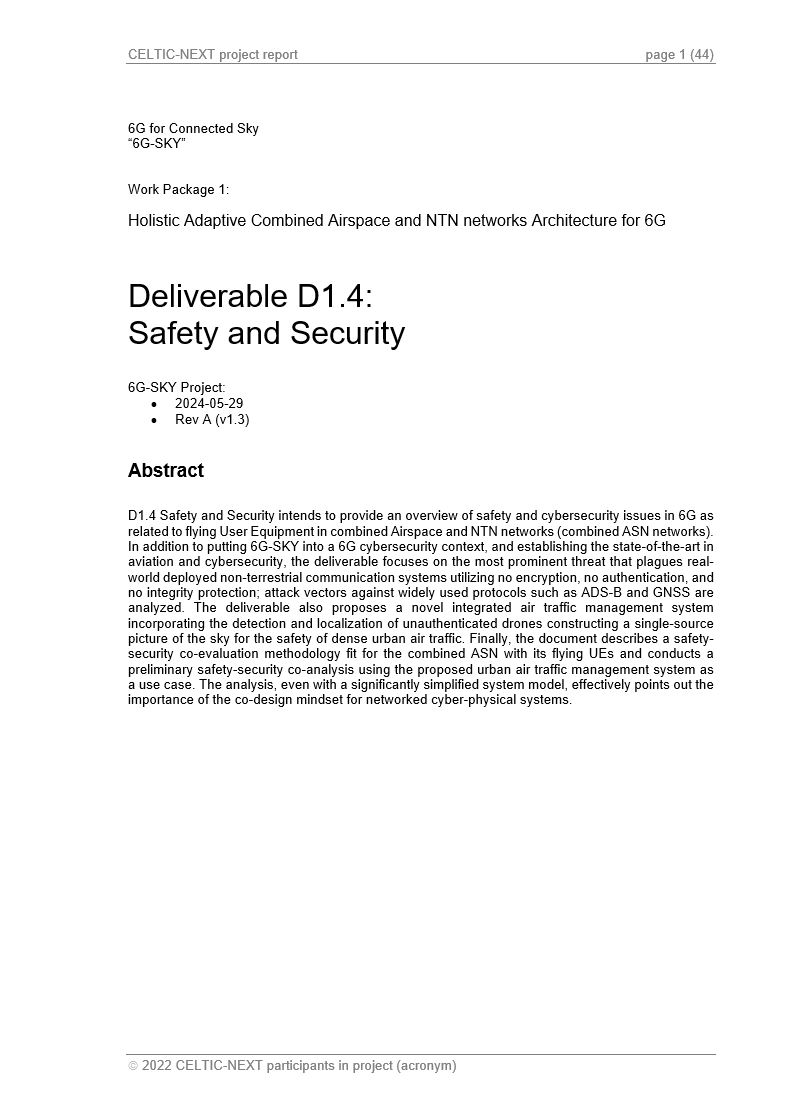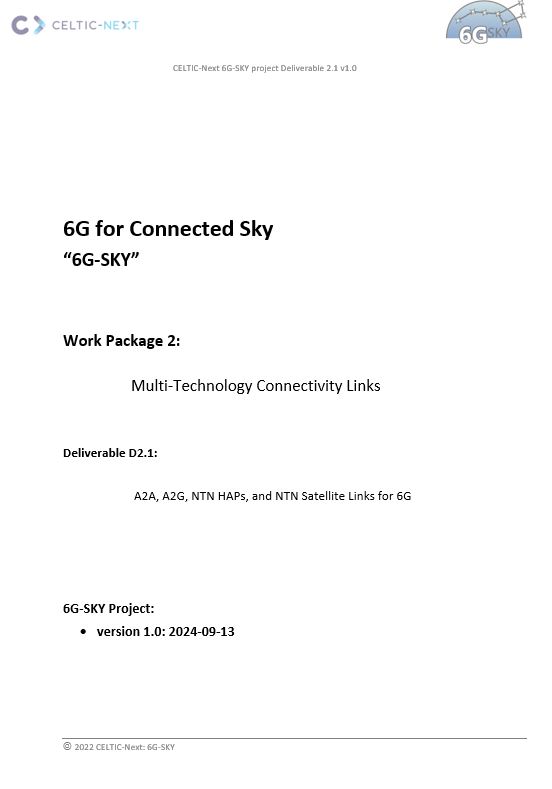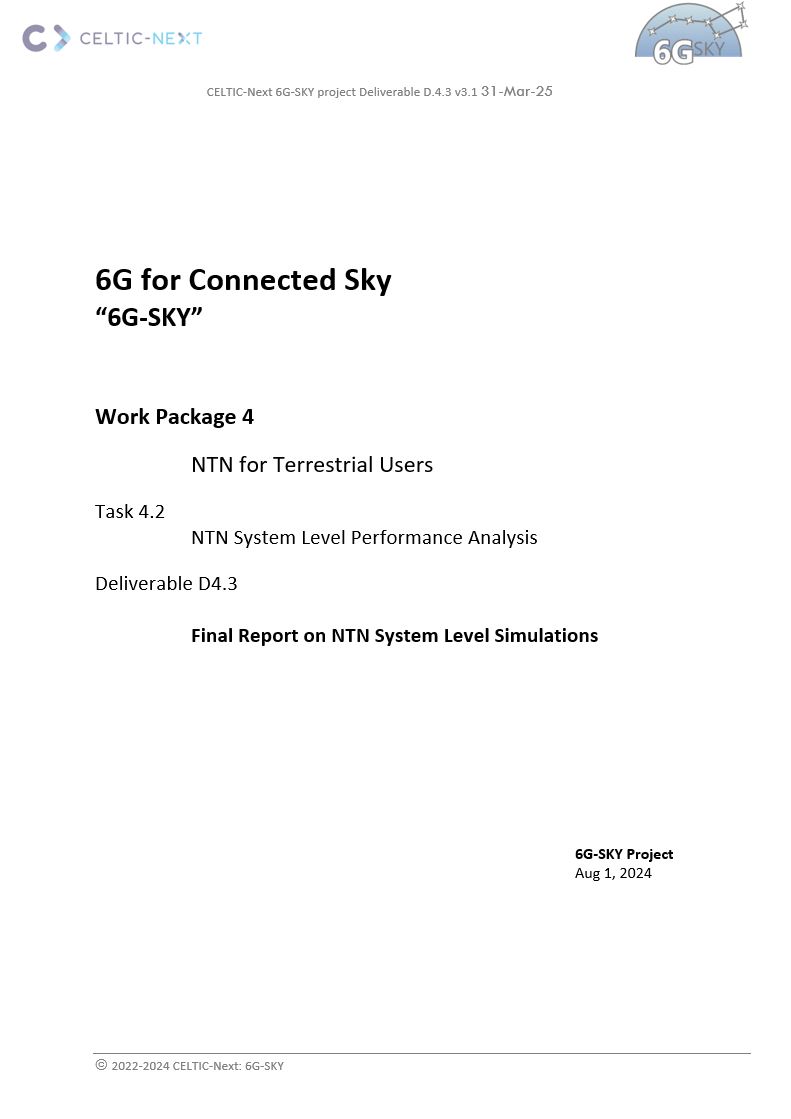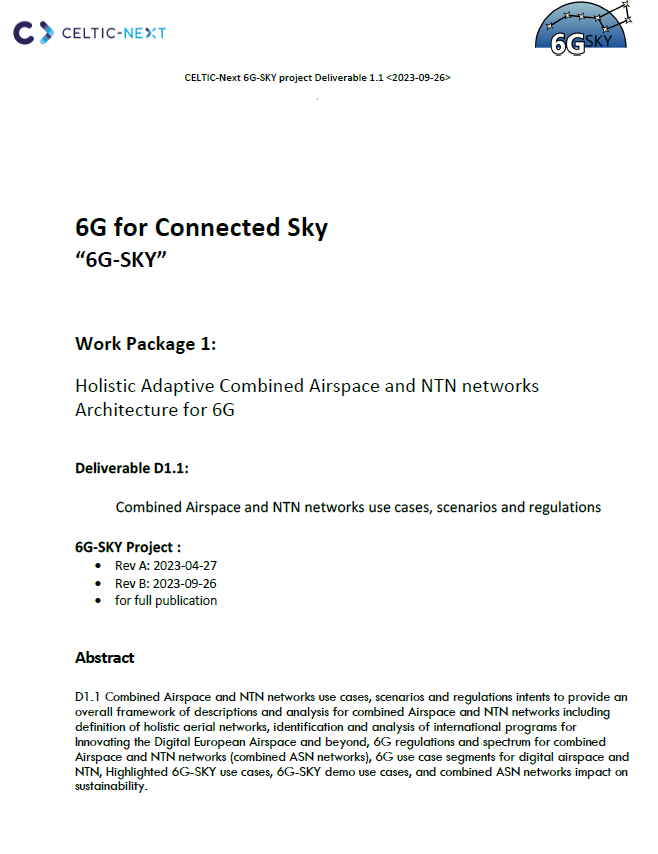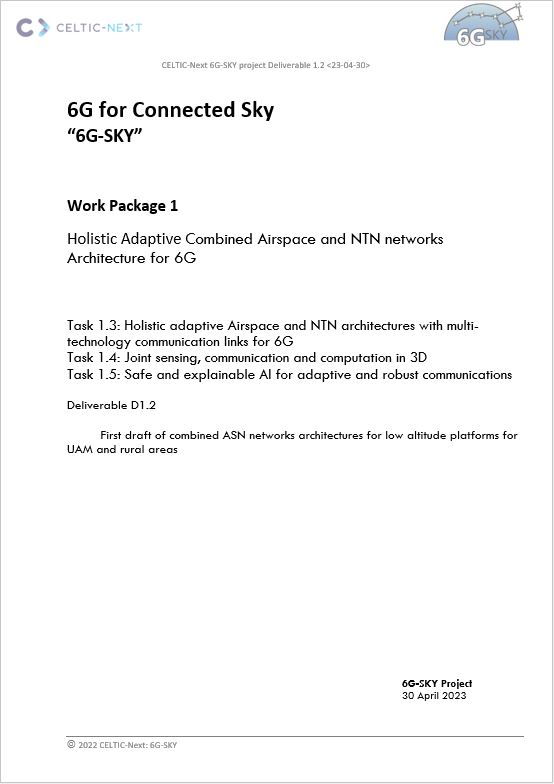6G-SKY Reports
A2G Antenna Concept: Measurement results of the antenna systems
June 10, 2025This report presents the lab test results of the novel demonstrator antennas concept tailored for the emerging 7 GHz cmWave frequency band. Our key findings include insights into outbid limitations of current PCB design rules. Additionally, we underscored the importance of expertise in soldering techniques specific to small geometries, highlighting their critical role in ensuring the structural interaction and optimal performance of the antenna unit.
Simulation Framework for Investigation of Antennas Integrated in Flying Vehicles and Their Performance in Real-World 3D Network Scenarios.
February 1, 2023This document presents a simulation framework for development and performance evaluation of antenna systems tailored for direct air-to-ground communications. A state-of-the-art review is presented in this document to help identifying the limitations and existing challenges in current direct air-to-ground antenna solutions. Ericsson Antenna Systems benefits from the novel active antenna system concepts, including radiator and array designs for the over-6-GHz spectrum, and state-of-the-art dynamic and energy-efficient beamforming strategies. Furthermore, Ericsson Antenna Systems also benefits from the antenna evaluation methodology introduced in this document, which can be readily adapted to other 6G enabling technologies.
Integration, Demonstrations and Lab Emulations
June 12, 2025This document, along with demonstrators and videos presents a comprehensive overview of the demonstration activities carried out within the scope of the 6G-SKY project. It documents the outcomes of each demonstration case, highlighting the motivations, the experimental setup, and the targeted performance metrics. Furthermore, each case includes success criteria and the specific 6G features under evaluation. This report details the procedures followed during the demonstrations, the environments in which they were conducted, and the partner contributions. Both hardware and software components involved in each demonstration are identified. The accompanying videos (final demonstration video is a part of the 6G-SKY title website) serve to visually support and validate the reported findings.
Initial Report on NTN System-Level-Simulator
Novemver 4, 2025This D4.2 provides an initial draft of the system level simulator (SLS) focusing on non-terrestrial networks (NTN) for terrestrial users. This report outlines the SLS architecture, the current limitations and the new functionality that will be developed during the project to accurately model the selected scenarios. The scenarios are selected to cover the 3D architecture of combined airspace and nonterrestrial networks (ASN). This report will form the basis for the further development of the SLS and will be supplemented with results and analysis at the end of this work package.
Most promising tracks of 3D Wireless Network Design and Management
June 30, 2024This report addresses the design and management of enabling network functions such as synchronization, positioning, sensing, and drone swarm connectivity. Key focus areas include ground-based sensing of aerial objects, earth observations through densely spaced satellite networks, and the complex connectivity challenges of drone swarms.
Business Modelling
May 20, 2025This report identifies value chains/networks for combined airspace and NTN integrated with TN, further provides Business model canvas analysis for certain value chains and actors, and highlights business simulations of certain use cases.
Holistic Adaptive Combined Airspace and NTN networks Architecture for 6G
September 26, 2023Final report on holistic adaptive combined Airspace and NTN architectures for 6G” intends to provide an overall framework of descriptions and analysis of holistic adaptive combined Airspace and NTN architectures for 6G, including a definition of holistic aerial networks, an identification and analysis of international programs for Innovating the Digital European Airspace and beyond, 6G regulations and spectrum for combined ASN networks, 6G use case segments for digital airspace and NTN, highlighted 6G-SKY use cases, holistic adaptive combined Airspace and NTN architecture integrated with TN, analysis of communication cases and technical solutions for Airspace and NTN platforms, and combined ASN networks impact assessment on sustainability. This material can be further used to trigger research investigations and commercial actions for the readers of the report.
System architecture and network design aspects for NTN-based communication for terrestrial users
March 30, 2024This report provides an overview of system architecture and network design aspects for NTN-based communication aimed at terrestrial users. The deliverable describes a survey of different approaches to achieve coverage for terrestrial services with NTN, considering aspects including functional split, cloud and edge architecture, integration with TN, etc. We then carry out studies and simulations for each topic and provide feasible solutions for the design of the 6G-NTN. The outcome of this document is also an input for evaluation that is showcased in the final report on NTN System Level Simulations and future studies.
Demonstration concept and planning
September 14, 2023This document details the demonstration cases as roughly sketched in the proposal under the topic “Integration, Demonstrations and Lab Emulations”. The demonstrations serve to show the functionality of the 6G-SKY architecture in different use cases. The use cases are described in further detail in the report “Combined Airspace and NTN Networks: Use Cases, Scenarios, and Regulations”, published on this webpage. The demonstrations shall specifically show which features beyond 5G+ are needed to fulfill use case requirements. The majority of demonstrations will target TRL5 and also show sustainability aspects (e.g., enhanced energy efficiency, greenhouse gas reduction, safety aspects). We also include schedules for setting up the demonstrations and we assign responsibilities for different contributions to the demonstrations.
Challenges of 3D Wireless Network Design and Management
August 31, 2023
This report encapsulates the challenges and considerations involved in designing and managing
communication networks for aerial use cases. Key objectives include achieving high data rates,
minimal latency, robust reliability, and integrating advanced sensing capabilities into the
network fabric. This holistic approach aligns with the overarching goal of the 6G-SKY project:
to pave the way for a technologically advanced and sustainable future in communication networks
for aerial scenarios.
The document explores various communication architecture solutions, including mesh networks and
device-to-device (D2D) coordination links. It also examines centralized versus distributed
control architectures, highlighting a range of strategic possibilities to meet the complex
requirements of individual use cases.
A standout theme within this document is the integration of sensing capabilities with
communication networks. This fusion enhances communication nodes with sensing abilities,
creating an infrastructure primed for distributed data processing. Such integration has the
potential to revolutionize the network's effectiveness, particularly in use cases that require
sophisticated sensing capabilities.
First draft of NTN architectures with focus on commercial airplanes, HAPS, HIBS, and satellites
May 29, 2024
The main focus of this report is on connectivity between non-terrestrial (NTN) nodes,
specifically for planes, unmanned aerial vehicles (UAVs), high-altitude platforms (HAPS), and
satellites.
To achieve this, we will identify architectural issues, requirements, and options for medium to
high altitude. Synergies towards smart cities, Industry 4.0, as well as the ongoing
digitalization of society and public safety will be explored from an architectural viewpoint.
The impact of HEXA-X 6G technology enablers, such as trustworthiness, connecting intelligence,
network of networks, global service coverage, and extreme experience, will be examined with a
focus on NTN.
Safety and Security
May 29, 2024This report addresses the critical imperative of ensuring both security and safety in the context of the combined Airspace and Non-Terrestrial Network (ASN) concept proposed by the 6G-SKY project within the broader landscape of 6G technology. It begins by highlighting the unique challenges posed by the cyber-physical nature of 6G-connected aerial vehicles, emphasizing the potential direct impact of cybersecurity threats on safety, including human lives.
In response to these challenges, the report advocates for a comprehensive approach that goes beyond traditional security attributes to address the specific requirements of the combined ASN architecture. It underscores the importance of considering spoofing as a prominent security threat targeting unauthenticated communication protocols, which could compromise critical functionalities like advanced localization and drone detection.
Multi-Technology Connectivity Links: A2A, A2G, NTN HAPs, and NTN Satellite Links for 6G
September 13, 2024This deliverable provides analysis of selected 6G links for air-to-air (A2A), air-to-ground (A2G), high altitude platform stations (HAPS), and non-terrestrial networks (NTN) satellite link communications. This report includes analysis of NTN satellite links from low earth orbit (LEO), medium earth orbit (MEO) and geostationary earth orbit (GEO) satellites serving as HAPS backhaul link. Analysis of links from HAPS to ground users focuses on providing coverage on rural areas, while analysis of A2G links between terrestrial base station and airborne users focuses on personal aerial vehicles and unmanned aerial vehicles (UAVs). A2A links are analyzed on the context of multi-technology links to serve UAVs. This report also analyzes free-space optics for use in Inter Satellite Links (ISL), Inter HAPS Links, links between satellites and HAPS and orbit-to-ground links (also called Direct To Earth (DTE)).
Final Report on NTN System Level Simulations
August 1, 2024The final report on “NTN System Level Simulations“ provides a comprehensive summary of the evaluation work conducted on the coexistence of terrestrial and non-terrestrial gNBs within the NTN System Level Simulator. Scenarios featuring flying gNBs at varying altitudes, as well as mobile users situated on the ground or in the air, were defined for this purpose. The necessary parameter configurations for initializing these scenarios—including satellite payload, user terminal, channel model, and traffic model properties—were established. The report also includes a list of key performance indicators, such as SNR and throughput, which are utilized to analyze the evaluated scenarios based on specific parameter configurations.
Furthermore, the report outlines the handover process between two non-terrestrial gNBs and highlights other features that will be developed throughout the project. The role of artificial intelligence (AI) in a 6G system is also explored in this context.
Combined Airspace and NTN Networks: Use Cases, Scenarios, and Regulations
September 26, 2023This report is intended for those readers that have an interest to get an overall view and understanding of combined Airspace and NTN networks (combined ASN networks).
The main benefits are that the Combined Airspace and NTN use cases, scenarios and regulations provide an overall framework of descriptions and analysis for combined ASN networks including a definition of holistic aerial networks, an identification and analysis of international programs for Innovating the Digital European Airspace and beyond, 6G regulations and spectrum for combined ASN networks, 6G use case segments for digital airspace and NTN, highlighted 6G-SKY use cases, 6G-SKY demo use cases, and a combined ASN networks impact on sustainability. This material can be further used to trigger research investigations and commercial actions for the readers of this report.
Holistic Adaptive Combined Airspace and NTN networks Architecture for 6G
April 30, 2023This report aims to provide the reader with the initial design considerations of architectures for the combined airspace and NTN networks (combined ASN networks) with a focus on low altitude aerial platforms including airplanes as users.
This project report first discusses the primary principles for the design of combined ASN network architectures. These principles for the holistic adaptive 6G-SKY network architecture require new functional views to assure three-dimensional (3D) service requirements via network functions such as 3D end-to-end (E2E) and domain-oriented network orchestration and slicing. Other dimensions shaping the 6G-SKY network architecture are the EU aviation strategy with EU Single European Sky (SES) and Single European Sky ATM Research (SESAR) initiatives and requirements from urban air mobility and advanced air mobility. The report discusses design aspects of the ASN architecture to enable efficient network management and control of the multi-layered architecture.

